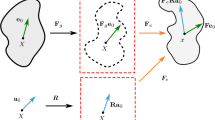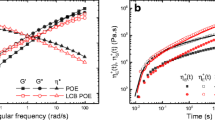Abstract
When a fiber is subjected to flow and mass transport, it deforms and swells and thus its orientation and length change accordingly. As a starting point, a semi-kinetic equation is proposed to describe the time evolution of the length and orientation of extensible fibers. Then a mesoscopic model, explicitly incorporating the coupling arising among flow, mass transport, and fibers extensibility and orientation in a mixture composed of a solvent and a fiber-reinforced polymer (FRP), is formulated. The derived governing and constitutive equations possess the GENERIC structure and are parameterized by mobility coefficients and the Helmholtz free energy density. The latter takes into account the orientational ordering of the fibers, the fiber-fiber topological interactions, and the flexible nature of the fibers. The unidirectional flow-free mass transport is thoroughly discussed via scaling analysis, numerical solutions, and comparison with sorption data selected from literature. The dynamics of the boundaries is also examined.











Similar content being viewed by others
References
Adib F, Neogi P (1987) Sorption with oscillation in solid polymers. AICHE J 33:164–166
Advani SG, Tucker CL (1987) The use of tensors to describe and predict fiber orientation in short fiber composites. J Rheol 31:751–784
Alfrey T, Gurnee EF, Lloyd WG (1966) Diffusion in glassy polymers. J Polym Sci Part C 12:249–261
Beris AN, Edwards BJ (1994) Thermodynamics of flowing system with internal microstructure. Oxford University Press, New York
Bird RB, DeAguir JR (1983) An encapsulated dumbbell model for concentrated polymer solutions and melts I. theoretical development and constitutive equation. J Non-Newtonian Fluid Mech 13:149
Bird RB, Armstrong RC, Hassager O (1987a) Dynamics of polymeric liquids, vol 1, 2nd edn. John Wiley, New York
Bird RB, Hassager O, Armstrong RC, Curtiss CF (1987b) Dynamics of polymeric liquids, vol 2, 2nd edn. John Wiley, New York
Bond DA (2005) Moisture in a fiber-reinforced composite: part I-non-Fickian transport and the effect of fiber spatial distribution, J. Compos Mater 39(23):2113–2141
Carbonell RG, Sarti GC (1990) Coupled deformation and mass-transport processes in solid polymers. Ind Eng Chem Res 29:194–1204
Cubaud JC, Hamelin P (1980) Composite materials in civil engineering. Appl Chem Eng Tech Mater:363–368
Doi M, Edwards SF (1986) The theory of polymer dynamics. Clarendon Press, Oxford
Durning CJ, Tabor M (1986) Modeling weakly non-linear two-stage sorption kinetics in glassy polymer films. Macromolecules 19:2220–2232
El Afif A (2008) Flow-diffusion-interface interaction in blends of immiscible polymers, Rheol. Acta 47:807–820
El Afif A (2014) Mesoscopic modeling of viscoelastic diffusion and flow into immiscible polymeric blends. Rheol Acta 53:549–558
El Afif A (2015) Flow and non-Fickian mass transport in immiscible blends of two rheologicalydifferent polymers, Rheol. Acta 54:929–940
El Afif A, El Omari M (2009) Flow and mass transport in blends of immiscible viscoelastic polymers. Rheol Acta 48:285–299
El Afif A, Grmela M (2002) Non-Fickian mass transport in polymers. J Rheol 46:591–628
El Afif A, Grmela M, Lebon G (1999) Rheology and diffusion in simple and complex fluids. J Non-Newton Fluid Mech 86:253–275
El Afif A, Cortez R, Gaver DP, De Kee D (2003a) Modeling of mass transport into immiscible polymeric blends. J Chem Phys 118:10227–10243
El Afif A, Cortez R, Gaver DP, De Kee D (2003b) Modeling of mass transport into immiscible polymeric blends. Macromolecules 36:9216–9229
El Aissaoui A, El Afif A (2017) Non-Fickian mass transfer in swelling polymeric non-porous membranes. J Membr Sci 543:172–183
Fan X, Phan-Thien N, Zheng R (1998) A direct simulation of fiber suspensions. J Non-Newtonian Fluid Mech 74:113–135
Ferec J, Heniche MC, Ausias G, Carreau PJ (2008) Numerical solution of the Fokker-Planck equation for fiber suspensions: application to the Folgar-Tucker-Lipscomb model. J Non-Newtonian Fluid Mech 155:20–29
Flory P (1953) Principle of polymer chemistry. Cornell University Press, Ithaca, NY
Folgar F, Tucker CL (1984) Orientation behavior of fibers in concentrated suspensions. J Reinf Plast Compos 3:98–119
Grmela M (1984a) Particle and bracket formulation of kinetic equations. Contemp Math 28:125–132
Grmela M (1984b) Bracket formulation of dissipative fluid mechanics equations. Phys Lett A 102A(81):355–358
Grmela M (1985) Non-equilibrium extension of Simha-Somcynsky equilibrium theory of polymeric fluids. J Rheol 30:707
Grmela M, Ait Kadi A (1994) Rheology of inhomogeneous immiscible blends. J Non-Newtonian Fluid Mech 55:191–199
Grmela M, Carreau PJ (1986) Conformation tensor rheological models. J Non-Newtonian Fluid Mech 23:271
Grmela M, Ottinger HC (1997) Dynamics and thermodynamics of complex fluids: general formulation. Phys Rev E 56:6620–6633
Hairch Y, El Afif A (2020) Mesoscopic modeling of mass transport in viscoelastic phase-separated polymeric membranes embedding complex deformable interfaces. J Membr Sci 596:117589
Hussain F, Hojjati M, Okamoto M, Gorga RE (2006) Polymer-matrix nanocomposites, processing, manufacturing and application: an overview. J Compos Mater 40:61–266
Jeffery GB (1922) The motion of ellipsoidal particles immersed in a viscous fluid. Proc Royal Soc London A 102:161–179
Joung CG, Phan-Thien N, Fan XJ (2001) Melt rheology of filled thermoplastics. Rev Chem Eng 4:205
Karbhari VM, Chin J, Hunston D, Benmokrane B, Juska T, Morgan R, Reynaud AD (2003) Durability gap analysis for fiber-reinforced polymer composites in civil infrastructure. J Compos Constr 7:238–247
Khokhlov AR, Semenov AN (1985) On the theory of liquid-crystalline ordering of polymeric chains with limited flexibility. J Stat Phys 38:161–182
Maier W, Saupe A (1960) Z Naturforschung 15a: 287
Minelli M and Sarti GC (2018) Gas transport in glassy polymers: prediction of diffusional time lag, Membrane 8:8
Neogi P (1983) Anomalous diffusion of vapors through solid polymers, Part II: Anomalous Sorption, AIChE 29 :833–839
Ottinger HC, Grmela M (1997) Dynamics and thermodynamics of complex fluids. Phys Rev E 56:6620–6633
Rajabian M, Dubois C, Grmela M (2005) Suspensions of semi-flexible fibers in polymeric fluids: rheology and thermodynamics. Rheol Acta 44:521–535
Sanopoulou M, Stamatialis DF, Petropoulos JH (2002) Investigation of case II diffusion behavior. 2. Study of the poly(methylmethacrylate)-methyl alcohol system by two-beam microinterferometry. Macromolecules 35:1021–1027
Schmid CF, Switez L, Klingenberg D (2000) Simulation of fiber flocculation: effects of fiber properties and inter-fiber friction. J Rheol 44:781–809
Thomas N, Windle AH (1978) Transport of methanol in poly(methyl methacrylate). Polymer 19:255–265
Vrentas JS, Duda JL (1977) Diffusion in polymer-solvent systems. III Construction of Deborah number diagrams. J Polym Sci Polym Phys 15:441–453
Wu LC, Peppas AN (1993) Modeling of penetrant diffusion in glassy polymer with an integral sorption Deborah number. J Polym Sci Polym Phys 31:1503–1518
Acknowledgments
This research did not receive any specific grant from funding agencies in the public, commercial, or not-for-profit sectors. Ali EL AFIF derived the model equations, wrote the paper and supervised the work, and Said Bentis solved numerically the one-dimensional equations and compared the predictions of the model with experimental data taken from literature.
Author information
Authors and Affiliations
Corresponding author
Ethics declarations
Conflict of interest
The authors declare that they have no conflict of interest.
Additional information
Publisher’s note
Springer Nature remains neutral with regard to jurisdictional claims in published maps and institutional affiliations.
Appendices
Appendix A
Fiber length-orientation distribution function
Let ψ(p)dp designates the square of the length of a fiber whose unit vector p is in the solid angle dp. Under the transformation, the length increases by a factor (L ′ /L)2, hence
The ratio (L ′ /L) is given by Eq. (13). The ratio (dp ’ /dp) can be obtained from the transformation rule of the vector p. To this end, we consider a cone with a height k and base area k2dp in the p space, and study how it is transformed when each of its points are transformed according to
The volume of the cone is
which it is transformed to
Now
From Eqs. (87) – (89), we have
Eq.(16) follows from Eqs.(85) and (90).
In the case of inextensible fibers, det E = 1 and L ′ = L. Thus, one easily recovers the classical distribution function for the fiber’s orientation
Appendix B
The time derivative of a regular real valued functional F = F(ρ, c, u, J a) is
The time derivative of F contains both reversible and irreversible contributions and can be written as
Using Eq. (4), we can write explicitly the reversible part as
Using Eq. (6), we can express the irreversible part as
Now by using Eqs. (93–96), and by matching the different terms corresponding to the same multiplication factor (for example for the same multiplication factor, (δF/δρ), we obtain the term (∂ρ/∂t) appearing in (93), \( \mathbf{\mathcal{L}}.\left(\delta \varPhi /\delta \rho \right) \) in (95) and (−δΞ/δ(δΦ/δρ)) in (96) and so on for the rest of the state variables), we can write the governing equations for the state variables as
Let us now determine each of the terms appearing in the governing equations. To this end, we start with the derived Poisson bracket (26), in which the function G is replaced by the free energy Φ , and then perform integration by parts. Thus the resulting Poisson bracket involves only derivatives of F and Φ with respect to the selected state variables. The next step is to factorize all the different terms that have the same Volterra derivative of F with respect to the same sate variable. For instance, for the state variable ρ the multiplication factor is (δF/δρ) and the associated term appearing in the Poisson bracket is −∂α(δΦ/δuα) which has in fact been designated previously by \( \mathbf{\mathcal{L}}.\left(\delta \varPhi /\delta \rho \right) \). We follow the same reasoning for the remaining state variables, i.e. (δF/δuα), (δF/δc), (δF/δJα) and (δF/δaαβ). Therefore, we obtain the following reversible terms corresponding to the reversible kinematics
We proceed in a similar way with the dissipation potential (27) to obtain the irreversible kinematics
Replacing Eqs. (98) and Eqs. (99) into Eqs. (97) gives Eqs. (28–35).
Appendix C
Derivation of Eq. (45)
Our aim here is to derive Eq. (45). We start with Eqs. (43) and replace them into Eq. (34). The result is
The same reasoning gives for the pressure
Using the assumption of absence of flow, i.e., v = 0, the symmetric second-order extra stress tensor is given by:
The mechanical equilibrium assumption, i.e., ∂αp + ∂βσβα = 0, gives
Now inserting Eq. (103) into Eq. (100) and using the fact that δφ/δρs = δφ/δρ + ((1 − c)/ρ)δφ/δc (since v = 0), we obtain a new simplified time evolution equation for the mass flux
Finally, using the incompressibility constraint ρ = Const, we have
Rights and permissions
About this article
Cite this article
Bentis, S., El Afif, A. Diffusion, extensibility, flow, and orientation coupling in polymers filled with extensible and flexible fibers. Rheol Acta 60, 23–47 (2021). https://doi.org/10.1007/s00397-020-01253-1
Received:
Revised:
Accepted:
Published:
Issue Date:
DOI: https://doi.org/10.1007/s00397-020-01253-1




